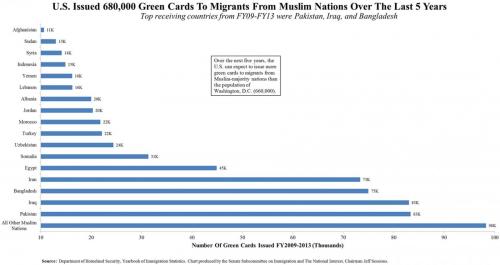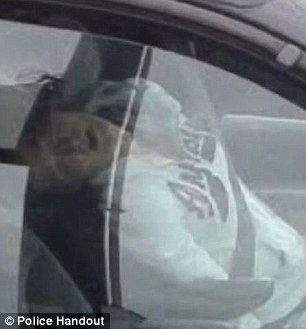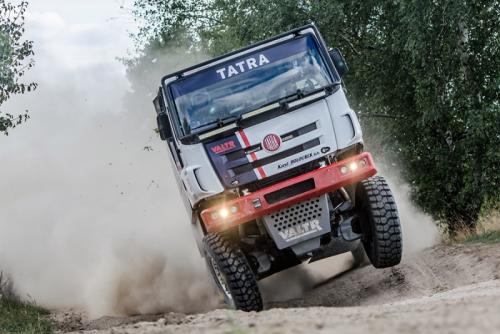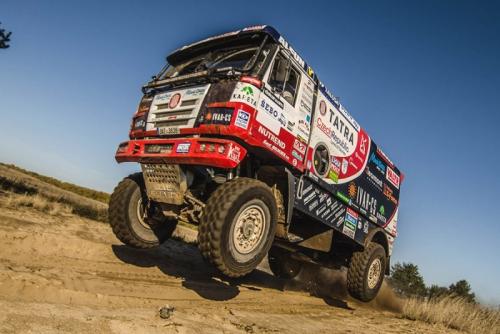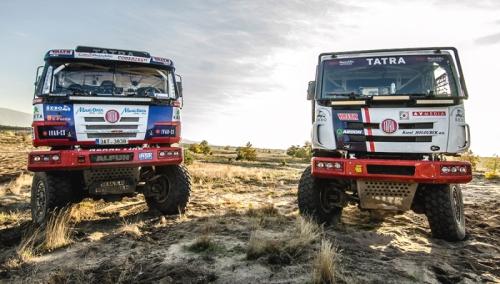
kscarbel2
Moderator-
Posts
18,550 -
Joined
-
Days Won
112
Content Type
Profiles
Forums
Gallery
Events
Blogs
BMT Wiki
Collections
Store
Everything posted by kscarbel2
-
New Mack Titan Heavy Haul Tractor
kscarbel2 replied to Jarhead Enterprises's topic in Modern Mack Truck General Discussion
Terry Dotson, now there's an icon from the days of Mack Trucks, Inc. -
http://www.bigmacktrucks.com/index.php?/topic/26220-1958-mack-v12-cummnins/?hl=lrvsw#entry128743 http://www.bigmacktrucks.com/index.php?/topic/30695-saw-this-big-mack-truck-moving-a-big-load-today/?hl=duffy#entry176135
-
Figures from the Department of Homeland Security (DHS) show the United States has issued green cards to 680,000 immigrants from Muslim countries over the last five years. The figure, higher than the population of Washington, DC, will repeat itself in the next five years unless immigration policies are changed, according to the DHS. In response to the 24 state governors who have vowed to block efforts to resettle Syrian refugees in their states following the November 13 terrorist attacks in Paris, Office of Refugee Resettlement (ORR) director Robert Carey sent out a letter this week proclaiming that states cannot deny benefits and services to refugees based on their nationality or religion, meaning Syrians cannot be discriminated against. The letter said states that do not comply with the requirement would be breaking the law and could be subject to enforcement action, including suspension or termination of the federally funded program. --------------------------------------------------------------------------------- Per Senator Jeff Sessions: According to published Department of Homeland Security (DHS) data, the U.S. issued 680,000 green cards to migrants from Muslim-majority countries in the five-year period from FY2009 through FY2013. Among those receiving green cards are individuals admitted to the United States as refugees, who must apply for adjustment to Lawful Permanent Resident (green card) status within 1 year of admission. Refugees have instant access to federal welfare and entitlements, along with local benefits and education services; these costs are not offset. 680,000 is not an estimate of total migration, as it does not include temporary migrants who return home, nor is it an estimate of population change, as it does not include births or deaths, among other considerations. Assuming no change in visa policy, the U.S. can expect to give green cards to another 680,000 more migrants from these countries over the next five years. A green card entitles recipients to access federal benefits, lifetime residency, work authorization, and a direct route to becoming a U.S. citizen. The numbers could be higher still: Census Bureau data shows migration from the Middle East to be one of the fastest-growing categories. Additionally, if left in place, the President’s refugee plan would substantially boost the annual number of migrants from this region admitted to the U.S. who, in turn, would be able to petition for their relatives to migrate to the U.S. in the future. Refugee and asylee admissions from Iraq, Somalia, and Iran alone contributed 124,000 individuals from FY09-FY13. Related reading - http://www.sessions.senate.gov/public/index.cfm/2015/11/subcommittee-chart-u-s-issued-680-000-green-cards-to-migrants-from-muslim-nations-over-the-last-five-years .
-
Too often, discussions of any one particular immigration program lack broader numerical context. Refugee admissions, asylees, and parolees are all additional to our huge annual intake of 1 million green card holders, the 700,000 foreign workers and the 500,000 foreign students. So before addressing the policy question of whether or not to admit additional groups of refugees, we should first consider our broader immigration situation. Senator Jeff Sessions Video - https://www.youtube.com/watch?v=rnkzi9bZ6Xw ------------------------------------------------------------------------------- Senator Jeff Sessions Says 12 Asylum Seekers Planned Attacks International Business Times / November 26, 2015 In an attempt to block President Obama's plan to admit 10,000 Syrian refugees next year, Senator Jeff Sessions has given 12 examples where radicalized refugees that have slipped through the cracks. The Alabama Republican released the list ahead of the December appropriations debate, during which Congress will decide how much federal money to give the president's refugee program. Since the November 13 terrorist attacks in Paris, Republicans have been raising concerns the U.S. could be the target of terror attacks from Syrian refugees admitted into the country as asylum-seekers. On the list is a Bosnian refugee who traveled to Syria to join ISIS just eleven days after becoming a U.S. citizen, and six of his countrymen who supported terrorists financially from back in the States. Senator Sessions' list includes refugees who have been arrested or indicted in the past year for aiding terrorist organizations, and include displaced people from Somalia, Uzbekistan, Kenya, and Bosnia. The 12 refugees arrested, indicted or convicted in year 2015 for terror charges: A warrant has been out for Liban Haji Mohamed's arrest since January, for providing material support to the terrorist groups Al-Shabab and Al-Qaeda. The 29-year-old is believed to have fled the country to join Al-Shabab in Eastern Africa three years ago, via the Mexican border after being put on a no-fly list. A former taxi-cab driver in Washington, DC, Mohamed first came to the U.S. as a refugee from Somalia. Carl Ghattas, Special Agent in Charge of the FBI’s Washington, D.C. Field Office, said it was important to locate Mohamed 'because he has knowledge of the Washington, D.C. area’s infrastructure such as shopping areas, Metro, airports, and government buildings . . . [t]his makes him an asset to his terrorist associates who might plot attacks on U.S. soil.' Abdinassir Mohamud Ibrahim moved to the United States as a refugee from Somalia in 2007 at the age of 22. In February, he was sentenced to 15 years in prison for providing material support to Al-Shabab. He also admitted to lying on his refugee application, saying he was a member of the minority Awer clan in Somalia that was being persecuted by the majority Hawiye clan. In fact, Ibrahim was part of the Hawiye clan and related 'to known Somali terrorists'. Abdullah Ramo Pazara came to the U.S. as a Bosnian refugee and left to fight with ISIS in Syria just eleven days after officially becoming an American citizen in 2013. Pazara has not been charged with supporting a foreign terrorist organization because he is believed to be dead, however, six of his fellow Bosnian natives (follows) were arrested for supporting terrorism in the Middle East. According to reports, at the time of his death, Pazara had climbed the ISIS ranks to become a deputy to one of the organization's top commanders. Bosnian war hero Ramiz Zijad Hodzic, who came to the U.S. as a refugee, was charged in February with conspiring to provide material support and resources to terrorists, with providing material support to terrorists, and conspiring to kill and maim persons in a foreign country. According to the indictment, Hodzic purchased military equipment to give Pazara (number two on this list) to use when he joined ISIS including 'United States military uniforms, tactical combat boots, military surplus goods, tactical gear and clothing, firearms accessories, optical equipment and range finders, rifle scopes, equipment, and supplies'. Ramiz Zijad Hodzic's wife, Sedina Unkic Hodzic was also charged in February with conspiring to provide material support and resources to terrorists and providing material support to terrorists. Sedina, according to the indictment, raised funds for ISIS and wired the money abroad. She is also said to have shipped six boxes of U.S. military uniforms, combat boots, tactical clothing and gear, military surplus items, firearms accessories, rifle scopes, optical equipment, first aid supplies, and other equipment to foreign terrorists. Fellow Bosnian Armin Harcevic was charged in February with conspiring to provide material support and resources to terrorists, and with providing material support to terrorists. He allegedly collected money from third parties to sent to terrorists abroad. Like the other Bosnians, Nihad Rosic was charged in February with providing material support to foreign terrorists. But he is also believed to have been planning to leave the country in order to join jihadist in Syria as well. Before his arrest, Rosic was a truck driver and former mixed martial arts fighter, who had a criminal history including a charge for punching a woman in the face while she held a child and beating his girlfriend with a belt. Bosnian-born Mediha Medy Salkicevic worked at a cargo company operating out of Chicago's O'Hare airport before her arrest in February for providing material support to terrorists. She allegedly raised funds and then wired it to terrorists, along with her own money. Bosnian Jasminka Ramic faces charges of conspiring to provide material support and resources to terrorists and providing material support to terrorists. Abdurahman Yasin Daud was born in a refugee camp in Kenya, to a Somalian family, and eventually came to the U.S. at the age of nine, going on to become a permanent resident. He was arrested along with six others for attempting to flea the country to Syria to join ISIS, according to an criminal complaint filed in April. Guled Ali Omar was also born in a Kenyan refugee camp to Somalian parents and immigrated to the United States as a child. His older brother Ahmed Ali Omar, left the United States in 2007 to fight with Al-Shabab and another one of his brothers, Mohamed Ali Omar, was convicted in March for threatening federal agents. Omar himself was arrested in April for conspiracy and attempt to provide material support to ISIS. U.S. Attorney for the District of Minnesota, Andy Luger, said that Omar previously tried to leave the U.S. and 'never stopped plotting'. Fazliddin Kurbanov came to the U.S. with his family as a refugee from Uzbekistan in 2009. Kurbanov was reportedly born a Muslim, but his family later converted to Orthodox Christianity. When he came to the U.S., it's believed he converted back to Islam and radicalized. In August, he was found guilty on charges of conspiracy and attempting to provide material support to a terrorist organization and possessing an unregistered destructive device. U.S. Assistant Attorney General John Carlin Kurbanov 'conspired to provide material support to the Islamic Movement of Uzbekistan and procured bomb-making materials in the interest of perpetrating a terrorist attack on American soil.'
-
When the Russian bomber was shot down [over Syria], Russia sent out two "search and rescue" helicopters to save the flight crew. When one of the helicopters landed, it was blown up by militants with a U.S.-made TOW anti-tank missile. The American TOW missile system was provided to the militants by Saudi Arabia, and delivered via Turkey. Related reading - http://www.businessinsider.sg/syria-rebels-and-tow-missiles-2015-10/?r=US&IR=T
-
The story behind Thanksgiving – what really happened Most people associate the holiday with happy Pilgrims and Indians sitting down to a big feast. And that did happen - once. In 1614, a band of English explorers sailed home to England with a ship full of Patuxet Indians bound for slavery. They left behind smallpox in the New World which virtually wiped out those who had escaped. As a result of the smallpox, the Pilgrims arrived in Massachusetts Bay to find only one living Patuxet Indian, a man named Squanto who had survived slavery in England and learned English. He taught the Pilgrims to grow corn and to fish, and negotiated a peace treaty between the Pilgrims and the Wampanoag Nation. At the end of their first year, the Pilgrims held a great feast honoring Squanto and the Wampanoags. But as word spread in England about the paradise to be found in the new world, religious zealots called Puritans began arriving by the boat load. Finding no fences around the land, they considered it to be in the public domain. Joined by other British settlers, they seized land, capturing strong young Indians for slaves and murdered the rest. The Pequot Indian Nation however had not agreed to the peace treaty Squanto had negotiated and they fought back. The Pequot War was one of the bloodiest Indian wars ever fought. In 1637 near present day Groton, Connecticut, over 700 men, women and children of the Pequot Tribe had gathered for their annual Green Corn Festival which is our Thanksgiving celebration. In the predawn hours, the sleeping Indians were surrounded by English and Dutch mercenaries who ordered them to come outside. Those who came out were shot or clubbed to death while the terrified women and children who huddled inside the longhouse were burned alive. It was a massacre. The next day the governor of the Massachusetts Bay Colony declared "A Day Of Thanksgiving" because 700 unarmed men, women and children had been murdered. Cheered by their "victory", the brave colonists and their Indian allies attacked additional Pequot village. Women and children over 14 were sold into slavery while the rest were murdered. Boats loaded with a many as 500 slaves regularly left the ports of New England. Bounties were paid for Indian scalps to encourage as many deaths as possible. Following an especially successful raid against the Pequot in what is now Stamford, Connecticut, the churches announced a second day of "thanksgiving" to celebrate victory over the heathen savages. During the feasting, the hacked off heads of Natives were kicked through the streets like soccer balls. Even the friendly Wampanoag did not escape the madness. Their chief was decapitated, and his head hung on a pole in Plymouth, Massachusetts for 24 years. The killings became more and more frenzied, with days of thanksgiving feasts being held after each successful massacre. George Washington finally suggested that only one day of Thanksgiving per year be set aside instead of celebrating each and every massacre. Later Abraham Lincoln decreed Thanksgiving Day to be a legal national holiday during the Civil War -- on the same day he ordered troops to march against the starving Sioux Indians in Minnesota. The Wampanoag Indians were not the friendly Indians as is traditionally told. Nor were they invited out of the goodness of the Pilgrims' hearts to share the fruits of the Pilgrims' harvest in a demonstration of Christian charity and inter-racial brotherhood. The Wampanoag were members of a widespread confederacy of Algonkian-speaking peoples known as the League of the Delaware. For six hundred years, the Wampanoag Indians had been defending themselves from my other ancestors, the Iroquois, and for the last hundred years they had also had encounters with European fishermen and explorers but especially with European slavers, who had been raiding their coastal villages. They knew something of the power of the white people, and they did not fully trust them. But their religion taught that they were to give charity to the helpless and hospitality to anyone who came to them with empty hands. Also, Squanto, the Indian hero of the Thanksgiving story, had a very real love for a British explorer named John Weymouth, who had become a second father to him several years before the Pilgrims arrived at Plymouth. Clearly, Squanto saw these Pilgrims as Weymouth's people. To the Pilgrims, the Indians were heathens and, therefore, the natural instruments of the Devil. Squanto, as the only educated and baptized Christian among the Wampanoag, was seen as merely an instrument of God, set in the wilderness to provide for the survival of His chosen people, the Pilgrims. The Indians were comparatively powerful and, therefore, dangerous; and they were to be courted until the next ships arrived with more Pilgrim colonists and the balance of power shifted. The Wampanoag were actually invited to that Thanksgiving feast for the purpose of negotiating a treaty that would secure the lands of the Plymouth Plantation for the Pilgrims. It should also be noted that the Indians, possibly out of a sense of charity toward their hosts, ended up bringing the majority of the food for the feast. A generation later, after the balance of power had indeed shifted, the Indian and White children of that Thanksgiving were striving to kill each other in the genocidal conflict known as King Philip's War. At the end of that conflict most of the New England Indians were either exterminated or refugees among the French in Canada, or they were sold into slavery in the Carolinas by the Puritans. This early trade in Indian slaves was so successful that several Puritan ship owners in Boston began the practice of raiding the Ivory Coast of Africa for black slaves to sell to the proprietary colonies of the South, thus founding the American-based slave trade.
-
President Vladimir Putin said on Thursday that Russia had given prior information to the United States of the flight path of the plane downed by Turkey on the Syrian border. "The American side, which leads the coalition that Turkey belongs to, knew about the location and time of our planes' flights, and we were hit exactly there and at that time," Putin said at a joint press conference with French counterpart Francois Hollande in the Kremlin. Putin on Thursday dismissed as "rubbish" Turkey's claim that it would not have shot down the jet if it had known it was Russian. "They [our planes] have identification signs and these are well visible," Putin said. "Instead of [...] ensuring this never happens again, we are hearing unintelligible explanations and statements that there is nothing to apologize about." ------------------------------------------ “We have still not heard any comprehensible apologies from the Turkish political leaders or any offers to compensate for the damage caused or promises to punish the criminals for their crime,” Putin said. “One gets the impression that the Turkish leaders are deliberately leading Russian-Turkish relations into a gridlock – and we are sorry to see this,” Putin added. ------------------------------------------ A Russian warplane recently entered Israeli-controlled airspace from Syria, says Israeli Defense Minister Moshe Yaalon. The brief intrusion was resolved quietly, with Yaalon noting “we must not automatically react and shoot them down when an error occurs." "There was a slight intrusion a mile (1.6 kilometers) deep by a Russian plane from Syria into our airspace, but it was immediately resolved and the Russian plane returned towards Syria," said Yaalon. "It was apparently an error by the pilot who was flying near the Golan," he said without elaborating when the incident had occurred. "Russian planes do not intend to attack us, which is why we must not automatically react and shoot them down when an error occurs," said Yaalon. ------------------------------------------ Putin has also accused Turkey of buying oil from the Islamic State jihadist group, whose financing heavily relies on the sale of energy resources. Putin said there was "no doubt" that oil from "terrorist-controlled" territory in Syria was making its way across the border into Turkey. "We see from the sky where these vehicles [carrying oil] are going," Putin said. "They are going to Turkey day and night." "These barrels are not only carrying oil but also the blood of our citizens because with this money terrorists buy weapons and ammunition and then organize bloody attacks," he added. ------------------------------------------ ISIS earns millions of dollars selling oil on the black market in Turkey, says Iraqi parliament member and former national security adviser Mowaffak al Rubaie. He also said wounded terrorists are being treated in Turkish hospitals. “In the last eight months ISIS has managed to sell ... $800 million dollars worth of oil on the black market of Turkey. This is Iraqi oil and Syrian oil, carried by trucks from Iraq, from Syria through the borders to Turkey and sold ...[at] less than 50 percent of the international oil price,” said Mowaffak al Rubaie. “Now this either get consumed inside, the crude is refined on Turkish territory by the Turkish refineries, and sold in the Turkish market. Or it goes to Jihan and then in the pipelines from Jihan to the Mediterranean and sold to the international market.” “Money and dollars generated by selling Iraqi and Syrian oil on the Turkish black market is like the oxygen supply to ISIS and it’s operation,” he added. “Once you cut the oxygen then ISIS will suffocate.” The Iraqi Iraqi parliament member said there is “no shadow of a doubt” that the Turkish government knows about the oil smuggling operations. “The merchants, the businessmen [are buying oil] in the black market in Turkey under the noses – under the auspices if you like – of the Turkish intelligence agency and the Turkish security apparatus,” he said. Citing Iraqi intelligence services, Mowaffak al Rubaie also accused Turkey of providing medical treatment to terrorists in hospitals along the border and at times even in “Istanbul itself.” “There are security officers who are sympathizing with ISIS in Turkey,” the Iraqi politician believes. “They are allowing them to go from Istanbul to the borders and infiltrate ... Syria and Iraq.” “There is no terrorist organization which can stand alone, without a neighboring country helping it – in this case Turkey,” Rubaie said, urging Ankara to come clean and join the international efforts to destroy the terror group.
-
"People should and do trust me" - Hillary Clinton
kscarbel2 replied to kscarbel2's topic in Odds and Ends
Sanders is 75 years old. I've nothing against the man but he's too old to be running for president. And a second term isn't even feasible. We all know that from age 50, our minds begin to slow. By age 80, it's very obvious. I don't feel a president's age should exceed 70 while in office. Both Hillary Clinton and Jeff Sessions are 68. The latter would be a far better choice. -
Boy, 7, and Parents Murdered in Ohio Associated Press / November 24, 2015 A 7-year-old boy and his parents were shot dead inside their Ohio home by a man who police said lived across the street. John E. Anderson, 31, his wife Christina Chaffin Anderson, 30, and their son, Landon Anderson, seven, were found dead by police inside their Hilltop home on Monday. Their daughter, 12-year-old Makyleigh Anderson, was also shot and was rushed to Nationwide Children’s Hospital in critical condition. All the victims suffered multiple gunshot wounds. Police were responding to a 911 call made by a woman about 5 p.m. who said that her husband had been shot by an intruder who was still inside their home. Barry Kirk, 50, was found running from the Anderson home and was shot after being chased by police. Three officers fired their weapons at him and he was hit multiple times. Kirk, who police said was “a neighbor who knew his murder victims,” was taken to Mount Carmel West, where he died. In 911 calls, both the daughter and Christina Anderson are reportedly heard begging a dispatcher for help. "Somebody's in my house; they're trying to hurt me and my mom and my brother. Please help," a girl's voice says. A family friend who lived in the house called it a "home invasion" in a second call. Gunshots can be reportedly heard in both calls. Kirk was investigated six years ago for threatening a mass shooting, according to police records. He threatened the shooting after becoming upset with an employee at the Ohio governor's office in July 2009 over an unemployment claim. "I guess I'm going to have to make a big boom or start shooting people," Kirk said. "I don't want to but I will get radical," Kirk said. "I just want you to know this so when it happens and hits the newspapers, you'll know it was me." When an investigator went to Kirk's house later that day and asked if he planned to shoot anyone, Kirk said he did, "without hesitation." A year later, in October 2010, Kirk pleaded guilty to a count of telephone harassment. He was fined and sentenced to a year's probation. Besides the telephone harassment conviction, Kirk served eight months in prison in the 1980s on a vandalism charge out of Cuyahoga County. He also was cited numerous times for traffic violations, and had 2004 charges of assault and domestic violence dismissed. .
-
Memphis mother murders toddler Associated Press / November 24, 2015 A teenage mother who allegedly killed her two-year-old son by placing him under a mattress and leaving him there for half an hour as a form of discipline has been indicted on a murder charge. Raven Campbell, 19, from Memphis, Tennessee, put little Jermyle Campbell under the mattress for “20 to 30 minutes” on numerous occasions to punish him. But this time, when she removed the heavy mattress from atop her son's body, he was not breathing. Paramedics arrived at the family home and the toddler was rushed to hospital, where he was declared dead. An autopsy later showed that he had passed away from dehydration and hyperthermia. The toddler was also found to have bite marks and scratches on his body. Campbell admitted to police that she was responsible. Campbell has been charged of first-degree murder in the perpetration of aggravated child abuse and neglect. She was also indicted on a count of aggravated child endangerment yesterday in relation to her toddler son's death. In June, Memphis Police revealed they had been called to the family home dozens of times before - for reasons ranging from domestic disturbances to woundings and a possible attempted suicide. Campbell is currently being held without bond. .
-
Pennsylvania father tortures and murders 6-week-old baby to death WGAL Susquehanna Valley / November 20, 2015 A 6-week-old baby boy has died just weeks after authorities say his father beat him. Pennsylvania State Police say 22-year-old John Tyler Howard-Bee caused traumatic physical injuries to his son, Connor Howard-Bee. Howard-Bee is now charged with homicide. According to police, Howard-Bee originally denied causing harm to his son, but later admitted to police that he hit and shook the baby to "get him to stop crying." The father is also accused of jamming his thumb into the baby's eye socket to try to quiet him. The infant was taken to Hershey Medical Center for treatment. While at the hospital, an examiner found that almost every bone in the baby's body was broken. After almost two months in intensive care, he died late last week. Police say Howard-Bee was the baby's sole caretaker at the time of the abuse. .
-
Houston baby burned to death in oven Associated Press / November 19, 2015 A Houston mother, Racquel Thompson, left her 19-month-old baby, two 3-year-old toddlers and 5-year-old son home alone so she could go out with her boyfriend to get pizza and pickup a prescription. The two 3-year-old siblings put the 19-month-old little girl in the oven and turned it on. The siblings say the baby J'Zyra Thompson, kicked the oven door while she was trapped inside. The oldest sibling, 5, was asleep at the time. Thompson said she attempted CPR, but the baby was already dead due to multiple burns. Police say Racquel Thompson had left the children without informing a grandmother who also lived at the apartment complex. Thompson told officials she often left the kids home alone to drive her boyfriend to work at a pizza place. The three surviving children are in foster care, as CPS could not find suitable relatives to care for them. Criminal charges are expected, though none have yet been filed. The ex-boyfriend father of at least two of the children, Fredrick Price, said he hadn't been in contact with the children in months. .
-
Reuters / November 24, 2015 The U.S. Marine Corps awarded Tysons Corner-based consulting firm [middle man] Science Applications International Corp (SAIC) and UK-based BAE Systems contracts for the first phase prototypes of a wheeled amphibious combat, the Pentagon announced on Tuesday. BAE is offering a variant of the Italian Iveco SuperAV (http://www.army-technology.com/projects/iveco-superav-8x8-armoured-personnel-carrier/). SAIC is offering a variant of the Singaporean Terrex (http://www.stengg.com/products-solutions/products/terrex-8x8-armoured-personnel-carrier). BAE Systems was awarded a $103.8 million contract for 13 vehicles. SAIC was awarded a $121.5 million contract, also for 13 vehicles. Last year the Marine Corps started a competition for the amphibious combat vehicle, with the first phase known as the Amphibious Combat Vehicle (ACV)1.1. The program will be a modest replacement for the tracked Expeditionary Fighting Vehicle that was being developed for the Marines by General Dynamics Corp before its cancellation in 2011 after large cost increases and technical issues. The competitors included Lockheed Martin Corp, General Dynamics, and Michigan-based Advanced Defense Vehicle Systems. At least one of them, Lockheed Martin, might file a protest. John Garner, program manager for the advanced amphibious assault, said the plan was to buy three more prototype vehicles from each company when funding was available. The Marine Corps will carry out testing, select one company from the two competitors, and make a production decision by “late spring, early summer of 2018,” Garner said. Garner said the first phase of the program would cost around $1.2 billion and the winner would ultimately produce 204 vehicles. Garner said that they were buying numerous prototype vehicles because it would allow the Marine Corps to shorten the testing period and not lead to delays if a vehicle needed repairs. He added that while land and water capabilities were given equal importance in making the selection, “extra credit” was given to the amphibious capability of the vehicle because “fundamentally this vehicle has to be an amphibious vehicle." The winning companies will build the vehicles in 2016, and conduct aggressive testing in 2017 that will inform the Marine Corps development of requirements for its next iteration of the vehicle — ACV 1.2 — according to Col. Roger Turner, director of the Marine Corps' Capabilities Development Directorate. The Marine Corps will be able to refine what ACV 1.2 will look like and then "we will move out with the remainder of the program once we know what details of ACV 1.1 will yield. ACV 1.1. has been met with criticism because it will likely be a displacement hull vehicle, meaning it bobs through the water at a low speed. Critics argue that slow-moving vehicles that must travel 100 miles to shore over the course of a few hours could be sitting ducks for enemies that can lob shore-based missiles at them in the water. But the Marine Corps believes it's taking the right path, saying its priority is to build wheeled vehicles that are well suited to move quickly across land, where the majority of missions will take place.
-
“We cannot take any more refugees in Europe. That’s impossible,” French prime minister Manuel Valls told journalists today. Meanwhile in Sweden, the locals are burning down the refugee centers, 17 so far (http://www.dailymail.co.uk/news/article-3315739/The-tranquil-Swedish-village-living-hell-refugee-invasion-locals-migrants-throw-stones-children-aged-five-need-POLICE-ESCORT-school.html). The Swedish government, which had gotten approval from its over-taxed people, now will finally begin to limit the refugee inflow. If Europe stops accepting refugees, will the White House agree to take more?
-
Former NATO Supreme Allied Commander General Wesley Clark explains that the existence of the Islamic State helps Sunni countries Turkey and Saudi Arabia geostrategically, by countering the shi'ite powers: Iran, Iraq and Syria. "All along there’s always been the idea that Turkey was supporting ISIS in some way… Someone’s buying that oil that ISIS is selling, it’s going through somewhere, it looks to me like it’s probably going through Turkey, but the Turks haven't acknowledged that." “Let’s be very clear: ISIS [iSIL] is not just a terrorist organization, it is a Sunni terrorist organization. It means ISIS blocks and targets Shia, and that means it’s serving the interests of Turkey and Saudi Arabia even as it poses a threat to them,” Clark said. "There’s no good guy in this, this is a power struggle for the future of the Middle East," concluded Clark. ------------------------------------------------------------------------------------------------------------------------------ Former NATO Supreme Allied Commander Gen. Wesley Clark responded to yesterday’s shoot down of a Russian fighter jet by pointing out that Turkey is supporting ISIS. Clark said there was a “larger context” to the incident, pointing out that ISIS is a Sunni terrorist organization and therefore targets Shia nations. “That means ISIS is serving the interests of Turkey and Saudi Arabia even as it poses a threat to them because neither Turkey or Saudi Arabia want an Iran-Iraq-Syria-Lebanon bridge that isolates Turkey and cuts Saudi Arabia off,” said Clark. Asked whether he agreed with Vladimir Putin that Turkey was aiding ISIS, Clark responded, “All along there’s always been the idea that Turkey was supporting ISIS in some way,” before going on to accuse Ankara of funneling ISIS terrorists through Turkey and buying ISIS’ stolen oil in the black market. “Someone’s buying that oil that ISIS is selling, it’s going through somewhere, it looks to me like it’s probably going through Turkey,” said Clark, before also going on to accuse Putin of supporting terrorists through his allegiance with Bashar Al-Assad. “There’s no good guy in this, this is a power struggle for the future of the Middle East,” concluded Clark. As we previously highlighted, $800,000,000 worth of ISIS oil has been sold in Turkey, a supposed U.S. ally. ISIS trucks are routinely allowed to cross back and forth between the Islamic State stronghold of Raqqa and Turkey. As Nafeez Ahmed documents, a large cache of intelligence recovered from a raid on an ISIS safehouse this summer confirms that “direct dealings between Turkish officials and ranking ISIS members was now ‘undeniable.’” A former ISIS communications technician also told Newsweek that part of his job was to, “Connect ISIS field captains and commanders from Syria with people in Turkey on innumerable occasions.” “ISIS commanders told us to fear nothing at all because there was full cooperation with the Turks,” he said. https://www.youtube.com/watch?v=DecIAlW9t9o ------------------------------------------------------------------------------------------------------------------------------ RT / November 27, 2015 Journalists from the Turkish newspaper Cumhuriyet were arrested Tuesday for reporting on the Turkish government’s illegal supplying of weapons to radical terrorists in Syria. The editor-in-chief Can Dundar and Ankara correspondent Erdem Gul were arrested for publishing photos of weapons being transported to Syria by Turkish intelligence (National Intelligence Organization, aka MİT) The trucks belonging to MİT were stopped by a prosecutor who sought to have the gendarmerie (military unit assigned to police duties) search the vehicles in the southern Turkish province of Adana in January 2014 before they crossed into Syria. Claiming that the trucks were carrying “humanitarian aid to Turkmens” in the war-torn Syria, the Turkish government accused the followers of U.S.-based Islamic scholar Fethullah Gülen in the state’s judiciary and security institutions of illegally ordering the search. On May 29, Cumhuriyet published photographs taken by the police and gendarmerie forces, showing artillery shells, mortar bombs and machine gun ammunition hidden in crates below boxes of medicine on the trucks. Turkish President Recep Tayyip Erdogan on live TV described the newspaper’s action as “espionage and treason”. Turkey has claimed it was sending medicine and other items for civilian use. However, the published photographs proved that underneath the medicine was heavy arms. Once published in the newspaper, Erdogan said: "So what if it’s arms? In another statement, President Erdogan said “So what if these are arms, we’re helping out the Turkmens in the region.” Journalists from Cumhuriyet newspaper accused by Erdogan of treason say they were doing their job, and alerted the public of what was going on in Turkish policy. After the newspaper broke the story, the government imposed a media blackout on the event.
-
You're exactly right. When the concept first came out (way back when), I was buying the Fumoto version (http://www.fumotousa.com/). They were the first. 100 percent trouble-free. I see a wide range of the Fumoto drain valves are on Amazon.
-
I've been using these in cars, pickups and commercial trucks for 35 years. Website - http://www.ezoildrainvalve.com/index.html Order direct - http://www.ezoilchangevalve.com/store/c1/Featured_Products.html Video - https://www.youtube.com/watch?v=RIfOPnb1cCw#t=80
-
Ohio mother celebrates birthday by overdosing on heroin behind the wheel with 3-year-old son in the backseat Associated Press / November 25, 2015 An Ohio man has saved the life of a mother who overdosed on heroin behind the wheel with the car engine running, while her 3-year-old son sat shivering and half-naked in the backseat. Edwin Gates was on his way to put brakes on a church member's car when he got stuck waiting for a car to pull into traffic near the local AutoZone. Gates waited and blew his horn before finally deciding to pass the car, but when he looked inside he saw a woman passed out. Rebecca Cooper, 27, was slumped in the driver's seat. It was her birthday. Gates said at first he thought she might have had a heart attack, and had his friend call 911 before checking her 'real low' pulse. Gates then switched off the car's ignition and put it into park. Cooper's engine was running and the car was in drive, her foot neither on the brake or gas pedal. The only thing stopping the vehicle from rolling into oncoming traffic was a pot hole that had caught the tire on the car's passenger side. Gates said he put the vehicle in park and switched the car's ignition off. That's when he saw the 3-year-old little boy, shivering without a shirt on in the backseat. He put a coat over the boy and waited for the paramedics. Cooper was revived with Narcan, which is used to reverse the effects of overdoses from heroin and certain types of pain killers. 'By the grace of God that van didn't roll out into traffic,' Gates told WCPO. 'She could've been dead and the kid could've been dead too.' Cooper has been charged with child endangerment and drug possession and was ordered to stay away from her son, who is now in her father's custody. The mother faced the same charges three years ago, but the child endangerment charges were dropped her. There have been 41 heroin-related traffic accidents in Cincinnati just this past year. .
-
watts wiring
kscarbel2 replied to Willie dog's topic in Antique and Classic Mack Trucks General Discussion
Mack Trucks for many years purchased its wiring harnesses from Dill Products in Norristown, Pennsylvania. Dill Products evolved into Fargo Assembly of PA, still operating in Norristown to the present day. The B-model main cab wiring harness (part number 41MR439) used to be around $300. -
To form an opinion on this, it’s important to hear both side of the story to gain a more rounded understanding. -------------------------------------------------------------------------------------- Turkey’s downing of Russian bomber a planned provocation RT / November 25, 2015 The downing of a Russian warplane in Syria by Turkey appears to be a pre-planned provocation, the Russian Foreign Minister said. Ankara failed to communicate with Russia over the incident, he added. “We have serious doubts that this act was unintentional. It looks very much like a preplanned provocation,” Lavrov said, citing Turkey’s failure to maintain proper communication with Russia, the abundance of footage of the incident and other evidence. Lavrov added that many Russian partners called the incident “an obvious ambush.” Earlier in the day, Turkish Prime Minister Ahmet Davutoglu slammed Russia for "attacks on Turkmen" in Syria, which according to Ankara preceded the incident with the downed Su-24. The Russian FM said the region where the incident happened is not just home to Turkmen people. There are also hundreds of foreign fighters affiliated with known terrorist groups and elements of their infrastructure such as weapons depots and command points there, he said. “I asked [Turkish FM Çavuşoğlu] whether Turkey’s close attention to this region, including the calls to create a buffer zone there, was motivated by a desire to protect this infrastructure from destruction. I didn’t receive any reply to this question,” Lavrov said. He added the downing of the Russian warplane occurred shortly after a series of airstrikes on terrorist oil convoys and facilities by the Russian Air Force. Lavrov said the incident “sheds new light” on the issue. The Russian diplomat criticized NATO for failing to express condolences to Russia over the loss of its troops lives. “Very strange statements were voiced after a NATO meeting called by the Turks, which didn’t express any regret or condolences and in effect were aimed at covering up what the Turkish Air Force did yesterday,” Lavrov said. “A similar reaction came from the European Union.” Lavrov reiterated the statements of the Russian Defense Ministry, which denied Ankara’s allegations that the Russian warplane had violated Turkish airspace. He added that even if Turkey’s words were taken on face value, its actions contradict its own position expressed in 2012, after Syria took down a Turkish military plane. At the time, then-Prime Minister Erdogan told the Turkish parliament that a short incursion into another nation’s airspace cannot justify an attack on it. Lavrov said Turkey should have done more to communicate with Russia prior to and right after the incident. The Russian minister said there was a question of American involvement in the downing of the Russian plane. According to his sources, the US demands all members of the anti-IS coalition led by Washington, who use US-made military aircraft, coordinate all deployments with the US military. “I wonder if this demand of the Americans covers… Turkey. If it does, I wonder whether Turkey asked permission from the US to fly its US-made planes and take down – let’s say 'an unidentified' – plane over Syrian territory,” Lavrov said. Lavrov said the problems at the Turkish-Syrian border could be solved by simply closing it, as suggested by French President Francois Hollande during his meeting with US President Barack Obama in Washington. “President Hollande suggested measures to close the Turkish-Syrian border to stop the flow of militants and finances to terrorists. It’s remarkable that President Obama didn’t react to it. I believe it’s a good suggestion and that during the visit tomorrow President Hollande will tell us details. We are prepared to consider these measures in earnest. Many people say that sealing the border would effectively eliminate the terrorist threat in Syria,” Lavrov said. https://www.youtube.com/watch?v=NCv3mRQLk1U#t=123
-
Hillary Clinton Apologizes for Saying ‘Illegal Immigrants’
kscarbel2 replied to kscarbel2's topic in Odds and Ends
Hillary Clinton pledges not to use term 'illegal immigrants' again The Guardian / November 24, 2015 Hillary Rodham Clinton said on Tuesday that her use of the term “illegal immigrants” was a “poor choice of words” and she pledged not to use it anymore, responding to criticism from immigration activists. The Democratic presidential frontrunner was asked about her use of the term to describe people who are in the US illegally during a question-and-answer session on Facebook held by Telemundo. The question came from Jose Antonio Vargas, a filmmaker and journalist whose organisation, Define American, has said the terminology is offensive and asked all presidential candidates to stop using it. “Yes, I will,” Clinton wrote during a stop in Boulder, Colorado. “That was a poor choice of words. As I’ve said throughout this campaign, the people at the heart of this issue are children, parents, families, DREAMers. They have names and hopes and dreams that deserve to be respected.” DREAMers take their name from the acronym for legislation that lays out a process toward citizenship for immigrants who were brought into the country illegally as children and grew up in the United States. During a town-hall meeting in New Hampshire earlier this month, Clinton said she voted “numerous times when I was a senator to spend money to build a barrier to try to prevent illegal immigrants from coming in. And I do think you have to control your borders.” Clinton has called for expanding President Barack Obama’s executive actions on immigration and overhauling US immigration laws, providing a pathway to citizenship for those living in the US illegally. Her plans mark a sharp contrast with Republican White House hopefuls, who have vowed to roll back the president’s immigration orders. Many Republican candidates also routinely use the term “illegals” to refer to immigrants in the country illegally. Clinton, during a subsequent rally in Boulder, said the US was “fighting for human rights and dignity and freedom” against terrorism and said the US was justified in allowing refugees to enter the US after a “strong vetting process”. Republican presidential candidates have largely opposed allowing refugees from Syria into the country. Republican frontrunner Donald Trump has suggested he would support ways to track Muslims in the US. “I’ve heard all of this loose and inflammatory talk about refugees,” Clinton said. “And I don’t think that does us any good at all in waging and winning the fight against criminals and killers who misuse religion and promote a different set of values than the ones that we believe in.” Clinton met in Boulder early Tuesday with relatives of mass shooting victims, and she later vowed to fight gun violence with tougher gun control laws. Clinton met with Jane Dougherty, sister of Mary Sherlach, who was slain at the Sandy Hook Elementary School shooting in Newtown, Connecticut, in 2012; Tom Sullivan and Matthew Jenks, the father and brother-in-law, respectively, of Alex Sullivan, who was killed in the 2012 movie theater shootings in Aurora, Colorado; and Coni Sanders, daughter of Dave Sanders, killed in the 1999 Columbine High School shootings in Colorado. “If 33,000 people were dying every year from something else, we’d surely do something about it,” Clinton said of US shooting deaths at a Denver rally. -
Volvo scales back job cuts in Sweden after union deal The International Business Times / November 25, 2015 World number two truck maker Volvo said on Tuesday it had withdrawn redundancy [layoff] notices previously handed out to 335 employees after a union deal cutting working hours and wages. Volvo said in a statement the redundancy notices referred to employees at its Tuve plant, on the west coast of Sweden. The deal with the IF Metal union meant working hours would be cut by 10 percent in addition to the existing two stoppage days per month while gross wages would be reduced by as much as 4 percent. An agreed pay hike would also be postponed to March 31 next year while the company pledged not to cut any further jobs in the interim period, the company said.
-
Tatra Trucks Press Release / November 24, 2015 The Tatra Buggyra Race Team with the new race-prepped Tatra Phoenix and Martin Kolomý's already race-proven Tatra 815 Buggyra are preparing to head to the most challenging motor race, the Dakar Rally. Demanding stress tests form a part of the preparations for the climax of this season. The Tatra Phoenix will be crewed by Jaroslav Valtr (two-time champion of the Czech Republic’s Offroad Marathon), Josef Kalina (three-time winner of the Dakar Rally) and newcomer Jiří Stross. The Tatra 815 will be piloted by teammate Martin Kolomý. The Euro-6 emissions rated Tatra Phoenix symbolizes a new era in truck racing at the 2016 Dakar Rally. Tatra will celebrate its 30th anniversary at Dakar in 2016, having first entered the race in 1986. To commemorate this significant anniversary, Tatra Trucks is preparing a series of special events. A regular production Euro-6 Tatra Phoenix 6x6 fitted with an 11-liter 430 horsepower engine and Contsystem (http://www.contsystem.cz/en/) superstructure featuring a Multilift XR hook loader will set off for the Dakar Rally as a support vehicle. In preparation for the Dakar Rally, the trucks underwent rigorous testing at the "Slovak Sahara" in the training area of Senica in October and early November. Tatra Trucks CEO Petr Karásek and Engineering Director Radomír Smolka both took turns behind the wheel and put both trucks through their paces. "Some of the chassis design and technological features of the new Phoenix are based on Martin Kolomý's proven TATRA 815 race truck. However, the overall concept has undergone major evolutionary modifications. For Tatra Trucks, the new Phoenix race truck is also an opportunity to test various technical solutions for regular production trucks," says Radomír Smolka. Tatra Trucks, as a part of the celebrations of the 30th anniversary of Tatra’s first entry in the Dakar Rally, then called the Paris-Dakar rally, is planning a series of activities, including a limited edition book tracing the history of truckmaker's participations in the Dakar Rally. Tatra Phoenix race truck specifications Type Tatra model 158-8P0R21.43 4x4.1 Engine 12.5-liter Gyrtech, in-line 6-cylinder Transmission ZF 16-speed with hydraulic gear shifting Transfer case Tatra single-speed with 1.30 reduction Chassis "Tatra" concept with the central back-bone tube and swinging half-axles; front and rear axles with disc brakes; front and rear air bellows suspension with Reiger shock absorbers and front anti-roll bar Tires 14.00R20 paired with central tire inflation system Wheels Hutchinson aluminum Wheelbase 4,290mm .
-
Commercial Carrier Journal (CCJ) / November 24, 2015 Celadon Trucking (CCJ Top 250 No. 35) hopes a new data-driven driver scorecard and a guaranteed pay program will help improve driver performance and attract and retain quality drivers, said Matt Douglass, Celadon vice president of operations, during a presentation at last week’s CCJ Fall Symposium in Scottsdale, Arizona. The driver performance scorecard measures drivers based on three metrics: Service, which is not yet live, will measure on-time pickups and deliveries as long as they are within the driver’s control. Celadon uses geofences around shippers to know when a driver arrives, Douglass explained. “Our main goal is to drive utilization and allow drivers to earn additional money.” Compliance includes idling and fuel purchases. Idling is seasonally adjusted, and all trucks have auxiliary power units, Douglass said. Celadon uses Manhattan Fuel & Route software to measure fuel compliance. “If a driver fuels at another location, we first check to make sure there wasn’t a problem such as he was stuck in traffic,” he said. Out-of-route will be added next year using ALK in-cab navigation, he said. Availability measures load acceptance, whether drivers are available to run freight if they have the hours, and time lost. Load refusals are not an instant driver failure, Douglass said. That decision comes from dispatch after investigating the reason for the refusal. Drivers have one hour to accept a load through either a verbal, Celadon’s Fleetwire driver app or macro confirmation. “The expectation is that drivers should be available and ready to run,” taking into account necessities such as doing laundry, Douglass said. Drivers have complete visibility into the program, which includes a rebuttal process that allows them to give reasons for negative events that impact their scores. At the time of an event, the driver receives a message explaining the situation. He has one week to reply with why he feels the negative event is incorrect. An unbiased team reviews all rebuttals and either accepts or rejects them. The driver scorecard is key to Celadon’s new WageLock guaranteed weekly pay structure and bonus program. The program allows company drivers whose driver scorecard puts them in the top two tiers for the week to “lock in” up to $1,000 per week, regardless of how many miles they drive. The program boosts pay for drivers who may have issues that affect their miles, such as layovers, maintenance problems and running short loads during the week. “For tier 1 and tier 2 drivers who fall below a weekly payout threshold, this pulls them up to give consistency,” Douglass said. All company drivers who are paid by the mile are eligible to participate with some exclusions such as switching between divisions and number of vacation days taken in a given week. Drivers must also scan in their paperwork from the previous trips in that week. “The goal is to get them to get their paperwork in quickly,” Douglass said. A technology leader, Celadon Trucking was recognized with CCJ’s 2015 Innovator of the Year for developing technology to score customers and loads in its network and for creating a career path in its customer service department. The company sees its latest data-driven solutions as a way to make drivers, especially those just coming out of its new driver school, successful and to help it compete in an increasingly tight driver market, Douglass said. “We like to fully utilize technology,” he said. “We’re a technology company that happens to run trucks.”
-
Hillary Clinton Apologizes for Saying ‘Illegal Immigrants’
kscarbel2 posted a topic in Odds and Ends
The Washington Times / November 224, 2015 Democratic presidential front-runner Hillary Rodham Clinton bowed to pressure from Hispanic activists Tuesday and apologized for using the term “illegal immigrants” at a town hall earlier this month. Clinton said it had been a “poor choice of words.” (Why is the accurate phrase to describe these people's status in the United States a “poor choice of words”?) Clinton has been pressed to retract her use of a term that offends people who entered the U.S. illegally, according to Hispanic activists who are demanding expanded immigration rights and citizenship for the country’s estimated 11 million illegal immigrants. She was prodded into an apology during a Facebook question-and-answer session hosted by the Spanish-language TV network Telemundo. The question came from Jose Antonio Vargas, a filmmaker and journalist whose organization, Define America, has led the charge to remove the term “illegal immigrants” from presidential campaigns. Mr. Vargas asked Clinton if she would stop using the term. “Yes, I will,” Clinton responded while logged in to Facebook during a stop in Boulder, Colorado. “That was a poor choice of words. As I’ve said throughout this campaign, the people at the heart of this issue are children, parents, families, Dreamers. They have names, and hopes and dreams that deserve to be respected.” Dreamers refers to illegal immigrants who were brought into the country as children and grew up in the United States. Under the Deferred Action for Childhood Arrivals, or DACA, these illegal immigrants are eligible for a renewable two-year work permit and exempt from deportation. Clinton used the phrase “illegal immigrants” for people who enter the U.S. illegally during a town hall meeting in New Hampshire. Defending her record on border security, the former first lady, senator and secretary of state said that she voted numerous times “to spend money to build a barrier to try to prevent illegal immigrants from coming in. And I do think you have to control your borders.” The support for the fence angers immigrant-rights advocates, but her use of the term “illegal immigrants” has landed her in more hot water. The Dream Action Coalition, a group advocating an end to deportations, said it sounded like Clinton was having an “identity crisis.” “Not only is Hillary’s casual use of the word ‘illegal’ offensive and dismissive, it shows us that she is out-of-touch with the community she claims to be advocating for by reducing them to a derogatory term,” said Hina Naveed, co-director of Dream Action Coalition. “There is no room to uplift a community when the conversation begins by taking away their identity.” Two founders of Dream Action Coalition, who are no longer with the group, have taken jobs with Clinton’s top competitor for the Democratic nomination, Senator Bernard Sanders. In her campaign for the White House, Clinton has promised to fulfill a wish list of activists who want an end to deportations and citizenship for illegal immigrations. She has proposed expanding President Obama’s executive actions on immigration, implement reforms to immigration laws and open a pathway to citizenship for most illegal immigrants. Clinton’s apology coincided with Sanders releasing his immigration agenda. He described it as a platform for creating a “humane” immigration system. He promised that within his first 100 days as president that he would expand Obama’s executive actions. The executive actions, however, have been halted by courts while the legitimacy of the actions are litigated. Sanders, a Vermont independent and avowed socialist, said that he would allow all undocumented immigrants who have been in the U.S. for at least five years to stay without threat of deportation. He said that would cover nearly 9 million illegal immigrants. Furthermore, he would pursue a complete overhaul of immigration laws and open a path to citizenship for current illegal immigrants. The gushing praise for Sanders’ plan underscored the tentative relationship Hispanic activists have with Clinton.
BigMackTrucks.com
BigMackTrucks.com is a support forum for antique, classic and modern Mack Trucks! The forum is owned and maintained by Watt's Truck Center, Inc. an independent, full service Mack dealer. The forums are not affiliated with Mack Trucks, Inc.
Our Vendors and Advertisers
Thank you for your support!


